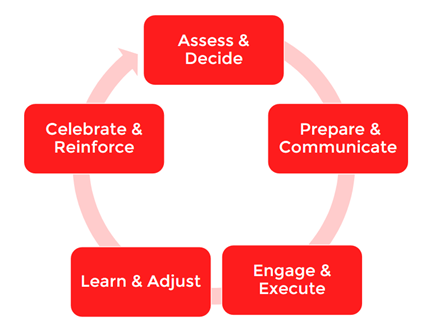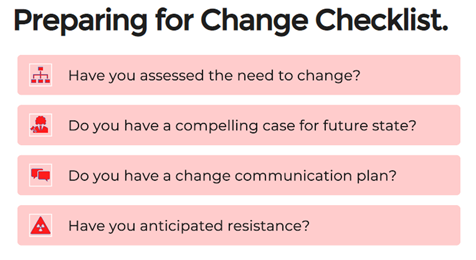Without change, our organizations at best miss opportunities, and at worse become obsolete. Every sustainably successful firm has adapted to shifting market forces. We must get good at change, and having a process to follow helps us do that.
This article is part of our Change Management series. For more information about this series visit our Change Resources page.
"If we don't change, we don't grow. If we don't grow, we are not really living.”
- Gail Sheehy
The Results Management Change Model
Leaders guide change to adapt their organizations to the needs and realities of the environments they compete in. A proven change framework gives them a step-by-step process to implement any change project while supporting employees through the journey. The Results Change Management Model helps to increase the speed of change (adoption of new behaviours and mindsets) while reducing the impact of resistance and creates the right foundation to sustain the change.
In this article, we introduce the 5-part Results Change Model and take a deep dive into part one and two.
For complimentary access to the full Model make sure you download the Leading Change Template and use it for your next change initiative.

Assess and Decide
The first step, Assess and Decide, answers the why question. Why do we want to make the change? What’s wrong with the current state? It forces us to create the business case to justify the cost, time, and potential distraction of the change. It also helps create a sense of urgency or a deadline when it comes to the inevitability of the change.
Organizational changes can be far-reaching and impact employees, customers, suppliers, organizational structure, systems, equipment, and outside parties. The business case must attempt to assess all these impacts.
“People don’t resist change.
They resist being changed!”
- Peter Senge
Another important question to ask at this stage is, “Does the change advance the organization's BHAG or Vision?” When the answer is “no”, we should reconsider. There will always be more change opportunities than we have the capacity to implement; selectivity, discipline and focus are crucial.
Prepare and Communicate
As previously written, leaders often assume that “if we build it, they will come.” Reasons for an organizational change may not be evident to all employees. Managers and senior leaders tend to have more and broader information about the state of the business itself and external factors.
This Prepare and Communicate phase ensures that the change is well understood by everyone. This applies to the organizational benefits (e.g., this will save us $4 million per year) as well as benefits for individual employees (e.g., this will make my job easier).
Sometimes changes will be positive for the organization and some employees, while having a negative impact on others (roles, structures, or even layoffs for instance). These need to be handled with particular care by leaders.
Successful change management depends on clear communication. A comprehensive communication plan should be developed and kept simple. It also must be adapted to every individual team and employee group based on how the change will impact each one of them.
Some guiding principles for communication that can also be helpful include:
- Avoid jargon
- Consider using an analogy, a metaphor, or tell a story
- Appeal to emotions
- Acknowledge contradictions
- Be consistent
- Be authentic
Repetition should also be part of the plan. The axiom of communicating a message at least seven times in seven different ways should be applied to the change communication plan.

Communication is a two-way street. Telling someone is only part of the formula. We must authentically listen as well, seeking to understand employees’ perspectives, fears, and concerns. Not only will this help with change implementation later, but it may present other unknown factors that could impact the change process or even force us to rethink the business case.
People change for their reasons, not yours. Every communication plan has to include the What’s In It For Me (WIIFM) perspective from the point of view of each employee. If not, voiced or silent resistance can undermine the implementation.
Change Planning is Essential
In this article we’ve explored the first two stages of the Results Change Model:
- Assess and Decide
- Prepare and Communicate
We’ll look at the other stages of the Results Change Model in future articles but know that these steps are essential to any significant change in your organization.
If you’d like to learn more about change or other ways you can take the simpler path to creating a great business, connect with us or consider attending one of our upcoming leadership events.




